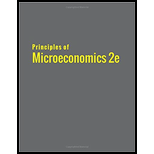
Exercise A1
Name three kinds of graphs and briefly state when is most appropriate to use each type of graph.
To state:
The different types of graphs.
Explanation of Solution
There are three types of graphs that is line graphs, pie graphs, and bar graphs.
A line graph is a graphical diagram which displays the changes in information over time. This is also referred as a line chart. In the line graph, there are points which are connected to information or data and shows continuous change. A line graph is used to compare different information, situations, and events. The lines in the graph can descend line or can ascend line based on data.
A pie graph or pie chart is used to display whole information, data, and statistics in an easy to read manner. A circle represents the whole data or group and it contains the slices of data called pie and the varying size of pie show how much data elements are existing in it. Generally, the pie graph used for classification of whole information into the subparts based on their characteristics.
A bar graph is a chart that uses the height of bars to depicts the comparisons between a set of information or data. These bars can be horizontal or vertical. For example, a comparison of the population between two countries India and China. The horizontal line will show the name of the country and the vertical line will show the size of the population. The bars constructed for these two countries will represent the comparison between these two country’s population.
Graphs: The graph is a two-dimensional diagram that shows the mathematical relationship between the variables. It represents the numerical data in visual figure to understand the data easily and quickly.
Want to see more full solutions like this?
Chapter A Solutions
PRINCIPLES OF MICROECONOMICS (OER)
Additional Business Textbook Solutions
Gitman: Principl Manageri Finance_15 (15th Edition) (What's New in Finance)
Horngren's Accounting (12th Edition)
Operations Management
Horngren's Financial & Managerial Accounting, The Financial Chapters (Book & Access Card)
Engineering Economy (17th Edition)
Business Essentials (12th Edition) (What's New in Intro to Business)
- Published in 1980, the book Free to Choose discusses how economists Milton Friedman and Rose Friedman proposed a one-sided view of the benefits of a voucher system. However, there are other economists who disagree about the potential effects of a voucher system.arrow_forwardThe following diagram illustrates the demand and marginal revenue curves facing a monopoly in an industry with no economies or diseconomies of scale. In the short and long run, MC = ATC. a. Calculate the values of profit, consumer surplus, and deadweight loss, and illustrate these on the graph. b. Repeat the calculations in part a, but now assume the monopoly is able to practice perfect price discrimination.arrow_forwardThe projects under the 'Build, Build, Build' program: how these projects improve connectivity and ease of doing business in the Philippines?arrow_forward
- Critically analyse the five (5) characteristics of Ubuntu and provide examples of how they apply to the National Health Insurance (NHI) in South Africa.arrow_forwardCritically analyse the five (5) characteristics of Ubuntu and provide examples of how they apply to the National Health Insurance (NHI) in South Africa.arrow_forwardOutline the nine (9) consumer rights as specified in the Consumer Rights Act in South Africa.arrow_forward
 Principles of Economics 2eEconomicsISBN:9781947172364Author:Steven A. Greenlaw; David ShapiroPublisher:OpenStax
Principles of Economics 2eEconomicsISBN:9781947172364Author:Steven A. Greenlaw; David ShapiroPublisher:OpenStax Economics (MindTap Course List)EconomicsISBN:9781337617383Author:Roger A. ArnoldPublisher:Cengage Learning
Economics (MindTap Course List)EconomicsISBN:9781337617383Author:Roger A. ArnoldPublisher:Cengage Learning








